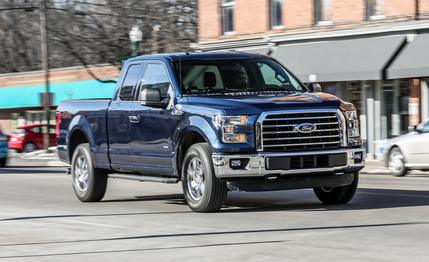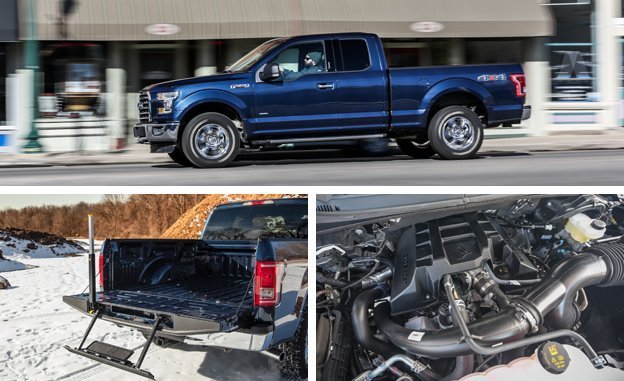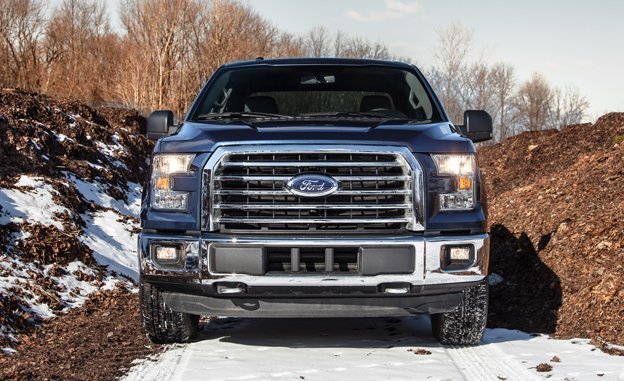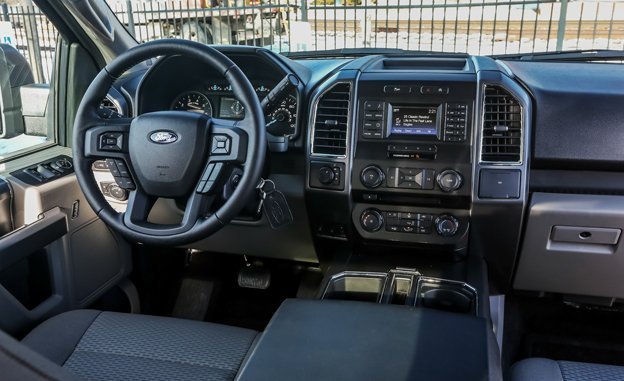
 Instrumented Test
From the May 2015 issue
Instrumented Test
From the May 2015 issue
We were skeptics of Ford’s aluminum-truck-bed-and-body gambit, but in a February-issue comparison test, a $60,000-plus F-150 SuperCrew with a twin-turbocharged 3.5-liter V-6 dispatched the mostly steel four-door competition from Chevrolet, Ram, and Toyota. But there’s a new, even smaller engine on the F-150’s order sheet, a 2.7-liter V-6. How, we wondered, would it fare under the hood of the mostly nonferrous Ford?
Positioned in price between the base 282-hp V-6 and the 385-hp 5.0-liter V-8, the iron-and-aluminum-block 2.7 makes 325 horsepower with the help of two turbos. The $795 upcharge for it over the naturally aspirated base six costs less than the F-150’s optional sunroof ($995). A V-8 runs $1595, and the top-hole 3.5-liter turbo V-6 is $1995.

 Top: A very truckish-looking truck driving in a pleasantly carlike manner but getting decidedly trucklike fuel economy.
Top: A very truckish-looking truck driving in a pleasantly carlike manner but getting decidedly trucklike fuel economy.
The 2.7 hustles this truck to 60 mph in 5.7 seconds and through the quarter-mile in 14.3. That’s 0.1 second slower to 60 and 0.1 second quicker in the quarter than the 365-hp 3.5-liter turbo V-6 that won the comparo. Consider it money well spent if you’re into holeshots, in the SuperCab at least.
At 4874 pounds, this model is more than 700 pounds lighter than that crew cab we keep referring to. We haven’t tested an extended-cab half-ton truck in a while, but we have tested the sub-half-ton Chevrolet Colorado. In crew-cab form, the 305-hp Colorado is more than 300 pounds lighter and 1.2 seconds slower in the quarter-mile.


The lack of full rear doors reminded us why the larger trucks have become so popular: We had to move the passenger seat up to comfortably fit an adult in the back seat. It’s not as tight as we remember extended cabs to be, but still no comparison to the limolike splendor of having four real doors.
Taking mass out of any truck while maintaining its payload capacity poses a challenge for chassis engineers. This F-150 carries up to 1626 pounds of people and stuff, which represents a 36-percent increase in mass over its unladen self. The rated payload capacity is 1740 pounds, with a gross vehicle weight rating of 6500 pounds. With such a large loaded-to-unloaded ratio, we expected the ride to be compromised, but it isn’t. Potholes and speed bumps induce no head toss, and the steering is uncharacteristically accurate for a truck. In fact, all of this F-150’s on-road behavior is carlike by truck standards.


Unfortunately, the 2.7 EcoBoost’s EPA fuel-economy ratings of 18 mpg city and 23 mpg highway don’t translate to the real world. We averaged 16 mpg over more than 1000 miles of mixed winter driving, and we didn’t load the bed with car parts, tow a trailer, or disable the overly aggressive stop-start engine function.
We love this F-150’s carlike demeanor and performance. But despite being quick off the line, the V-6s don’t sound or feel like truck engines, and that’s something we miss. For about $43,000, or the cost of this F-150, one could get a similarly equipped V-8 from Chevy or Ram. Show us someone who isn’t a sucker for a V-8 and we’ll show you a very nontraditional truck buyer.